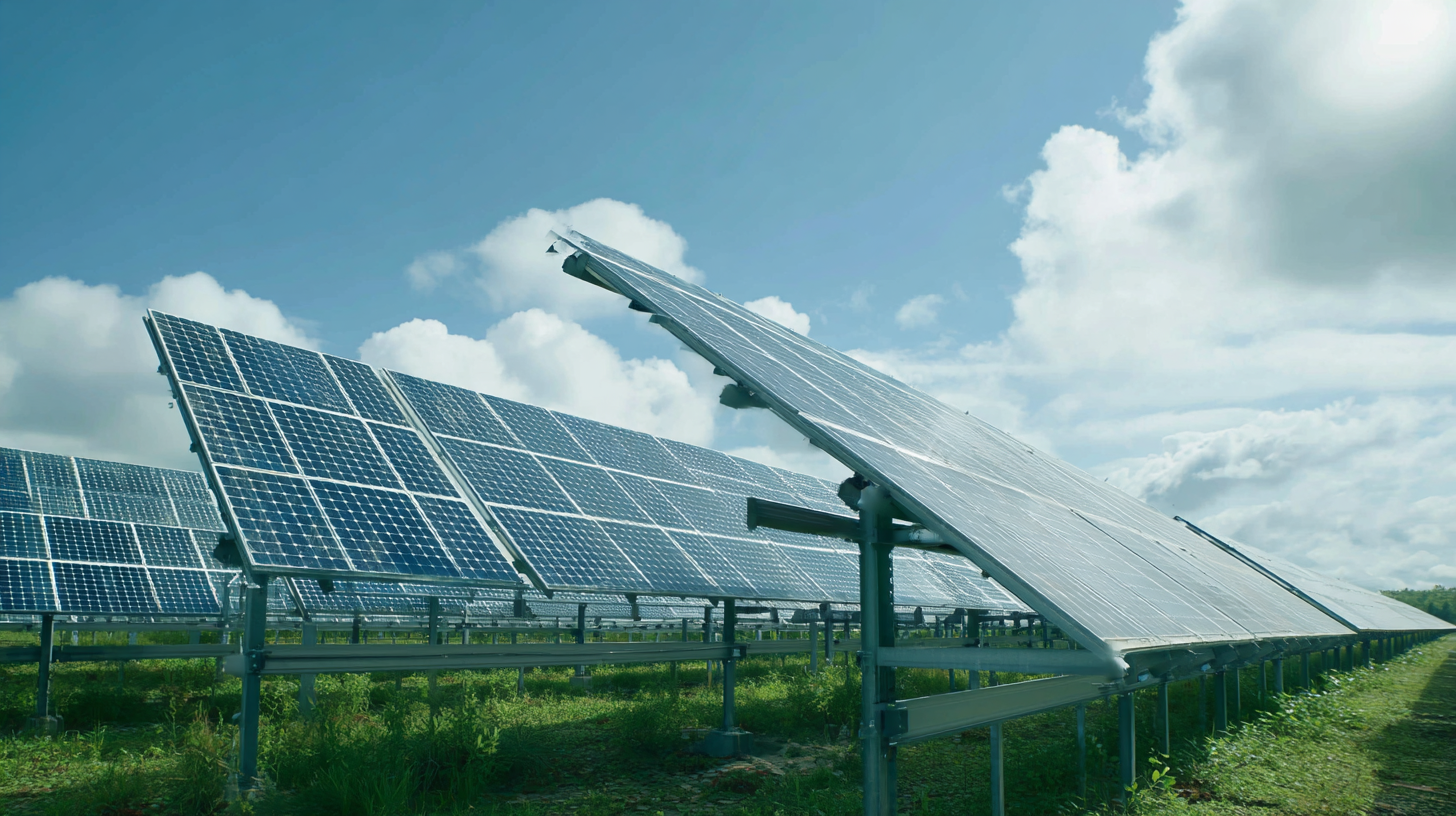
Blog
Navigating Industry Standards: Challenges in Sourcing the Best Green Solar Panels Globally
The increasing urgency for sustainable energy solutions has propelled green solar panels to the forefront of the renewable energy sector. According to a recent report by the International Renewable Energy Agency (IRENA), the global solar power capacity surged to over 710 GW in 2020, highlighting a significant rise in the adoption of solar technologies. However, the challenge remains in sourcing the best green solar panels globally.

Various studies indicate that while the market is flooded with options, the quality, efficiency, and environmental impact of these panels can vary significantly. A report from the National Renewable Energy Laboratory (NREL) points out that only a fraction of the available solar panels meet the stringent criteria for sustainability and performance. As stakeholders navigate through these complexities, understanding the nuanced landscape of industry standards becomes essential in making informed decisions that contribute to a truly green energy future.
Understanding Global Standards for Green Solar Panels: Key Regulations and Certifications
When sourcing green solar panels globally, understanding the applicable regulations and certifications is crucial for ensuring both quality and environmental sustainability. Each country has set forth its own standards that govern the manufacturing and performance of solar panels. For instance, in the European Union, the EcoDesign Directive requires solar products to meet energy efficiency targets and promote circular economy practices. This legislation aims to minimize waste and ensure that solar panels are designed for longevity and recyclability.
In addition to regional regulations, various global certifications play a significant role in guiding buyers toward compliant products. The International Electrotechnical Commission (IEC) provides standards that establish performance benchmarks for solar panels, ensuring they can withstand diverse environmental conditions. Furthermore, certifications such as the Cradle to Cradle and the Green Label indicate that a product meets strict sustainability criteria throughout its lifecycle. By prioritizing suppliers that adhere to these standards and certifications, businesses can effectively navigate the challenges in sourcing high-quality green solar panels, reinforcing their commitment to sustainable practices while contributing to global renewable energy goals.

Evaluating the Environmental Impact of Solar Panel Manufacturing Processes
The environmental impact of solar panel manufacturing processes is a critical aspect that demands attention as the industry strives for sustainability. According to the International Energy Agency (IEA), the production of solar panels accounted for about 13% of the total life cycle greenhouse gas emissions of solar energy systems as of 2022. This prompts the need to evaluate the manufacturing processes, including raw material extraction, energy consumption, and waste management, to minimize their ecological footprint effectively.
Moreover, a report from the Solar Energy Industries Association (SEIA) indicates that while advancements in technology have led to a reduction in emissions per watt produced, the overall demand for solar panels continues to increase, leading to heightened resource extraction and energy usage. For instance, the extraction of polysilicon, a primary component in most solar panels, has a significant environmental cost, estimated to use up to 36,000 liters of water per ton produced. Hence, selecting manufacturers who prioritize eco-friendly practices and sustainable sourcing is vital for mitigating the environmental impact associated with solar panel production.
Identifying Leading Manufacturers: Comparing Efficiency Ratings and Sustainability Practices
When sourcing the best green solar panels globally, identifying leading manufacturers involves a detailed comparison of efficiency ratings and sustainability practices. Efficiency ratings serve as a crucial metric, indicating how effectively a solar panel can convert sunlight into usable energy. Manufacturers often showcase their efficiency scores prominently, but a deeper examination reveals significant differences in technologies employed. Some companies may utilize monocrystalline cells, which tend to offer higher efficiency rates, while others may depend on polycrystalline panels, which can be less efficient but more affordable. Furthermore, evaluating the warranties and performance guarantees can provide insight into the manufacturer's confidence in their products.
Sustainability practices are equally vital in the decision-making process. Leading manufacturers increasingly prioritize environmentally friendly production methods and materials. This includes minimizing waste in manufacturing, utilizing recycled materials, and ensuring ethical sourcing of raw materials. It's also essential to consider the lifecycle assessment of the panels, which examines the environmental impact from production to disposal. A manufacturer committed to sustainability will have transparent sourcing policies and comprehensive recycling programs, demonstrating a genuine commitment to reducing their carbon footprint. By combining efficiency ratings with robust sustainability practices, consumers can make informed choices that not only meet their energy needs but also align with their environmental values.
Navigating Supply Chain Challenges in Sourcing Eco-Friendly Solar Technologies
As global demand for eco-friendly solar technologies increases, companies face significant supply chain challenges in sourcing high-quality green solar panels. The green technology market and sustainable development sector have experienced remarkable growth, with projections indicating a compound annual growth rate of 19.5% from 2023 to 2032. This trend is partly driven by rising corporate social responsibility initiatives, pushing companies to integrate sustainable practices into their operations.

When sourcing eco-friendly solar technologies, companies should focus on building robust relationships with suppliers who prioritize sustainability. This approach not only ensures a steady supply of high-quality materials but also fosters innovation in the sourcing process. Collaborating with local manufacturers can streamline logistics and reduce carbon footprints, ultimately aligning with the overarching goals of sustainability.
Additionally, companies should invest in supply chain transparency. Monitoring the sourcing process helps identify potential bottlenecks and ensures that suppliers adhere to eco-friendly standards. Implementing technology like blockchain can enhance traceability and accountability, ensuring that the solar panels sourced are indeed green and contribute positively to the environment. By embracing these strategies, businesses can navigate the complexities of sourcing sustainable solar technologies effectively.
Cost vs. Benefit Analysis: Investing in High-Quality Green Solar Panels for Long-Term Savings
Investing in high-quality green solar panels can significantly enhance long-term savings, despite the initial cost outlay. According to a report by the International Renewable Energy Agency (IRENA), while premium solar panels may be 20–30% more expensive upfront, they often yield up to 25% higher efficiency over their lifespan. This means better energy production and, ultimately, more savings on electricity bills. Moreover, high-quality panels typically come with longer warranties, diminishing the risk of early replacement and the associated costs.
Tip: When evaluating solar panels, look for those with certifications from recognized bodies like the Solar Energy Industries Association (SEIA). These certifications ensure that the products meet strict industry standards for performance and durability.
Furthermore, a cost-benefit analysis reveals that while cheaper solar options may appeal to budget-conscious buyers, they can lead to higher maintenance costs and lower energy output. A study conducted by the National Renewable Energy Laboratory (NREL) indicated that homeowners who opted for lower-priced panels often faced repairs or replacements within the first five years, negating their initial savings.
Tip: Always consider the total cost of ownership, including installation and potential maintenance, when selecting solar panels. Opting for a higher initial investment in quality can result in greater long-term financial returns.